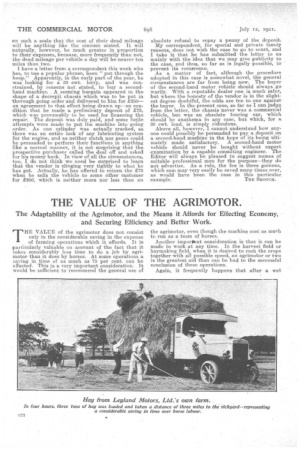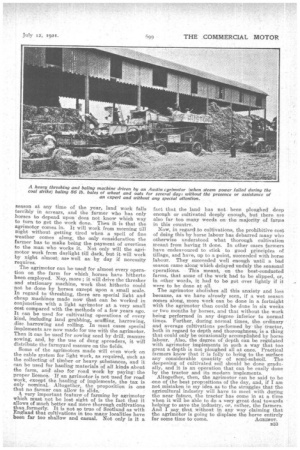THE VALUE OF THE AGRIMOTOR.
Page 28

Page 29

If you've noticed an error in this article please click here to report it so we can fix it.
The Adaptability of the Agrimotor, and the Means it Affords for Effecting Economy, and Securing Efficiency and Better Work.
THE VALUE of the agrimotor does not consist only in the considerable saving in the expense of farming operations which it affords. It is particularly valuable on account of the fact that it takes considerably less time to do a job by agrimotor than it does by horses. At some operations a saving in time of as much as 75 per cent, can be effected. This is a very important consideration. It would be sufficient to recommend the general use of
the agrimotor, even though the machine cost as much to run as a team of horses.
Another imporiaint consideration is that it can be made to work .at any time. In the harvest field or haymaking field, when it is desired to rush the crops together with all possible speed, an agrimotor or two is the greatest aid than can he had to the successful conclusion of these operations.
Again, it frequently happens that after a wet season at any time of the year, land work falls terribly in arrears, and the farmer who has only horses to depend upon does not know which way to turn to get the work done. Then it is that the agrimotor comes in. It will work from morning till night without getting tired when a spell of fine weather comes along, the only consideration the farmer has to make being the payment of overtime to the man who works it. Not only will the agrimotor work from daylight till dark, but it will work by night almost ass well as by day if necessity requires.
The agrimotor can be used for almost every operation on the farm for which, horses have hitherto been employed. Nay, more ; it will drive the thresher and stationary machine, work that hitherto could not be done by horses except upon a small scale. In regard to threshing, there are special light and cheap machines made now that can be worked in conjunction with a light agrimotor at a. very small cost compared with the methods of a few years ago. It can be used for cultivating operations of every kind, including land grubbing, scuffling, harrowing, disc harrowing and rolling. In most eases special implements are now made for use with the agrimotor. Then it cap be used for sowing seed by drill, manure sowing, and, by the. use of dung spreaders, it will distribute the farmyard manure on the fields.
Some of the agrimotors made will even work on the cable system for light work, as required, such as the collecting of timber or heavy substances, and it can be used for hauling materials of all kinds about the farm, and also for road work by paying' the proper licence. If an agrimotor is not used for road work, except the hauling of implements, the tax is only nominal. Altogether, the proposition is one that no farmer can allow to slide,' A very important feature, of farming by agrimotor which must not be lost sight of is the fact that it allows of much better and more thorough cultivations than formerly. It is not so true of Scotland as with England that cultivations in too many localities have been far too shallow and casual. Not only is it a fact that the land. has not been ploughed deep enough or cultivated deeply enough, but there are also far too many weeds on the majority of fareas in this country.
Now, in regard to cultivations., the prohibitive cost of doing this by horse labour has debarred many who otherwise understood what thorough cultivation meant from having it done. In other cases farmers have endeavoured to stick to good principles of tillage, and have, up to a point, succeeded with horse labour. They succeeded well enough until a bad season came along which delayed unduly the seasonal operations. This meant, on the best-conducted farms, that some of the work had to be slipped, or, in other words, it had to be got over lightly if it were to be done at all.
The agrimotor abolishes all this anxiety and loss because, as we have already seen, if a wet season comes along, more work can be done in a fortnight with the agrimotor than could be done in six weeks or two months by horses, and that without the work being performed in any degree inferior to normal times. Further, during normal times' the ordinary and average cultivations performed by the tractor, both in regard to depth and thoroughness, is a thing that could only be occasionally accomplished by horse labour. Also, the degree of depth can be regulated with agrimotor implements in such a way that too great a depth is not ploughed all at once. Praetical farmers know that it is folly to bring to the surface any considerable quantity of semi-subsoil. The deepening of cultivated soil should be done gradually, and it is an operation that can be easily done by the tractor and its modern implements. Altogether, then, the agrimotor can be said to be one of the best propositions of the day, and, if I am not mistaken in my idea as to the struggles that the agricultural industry will have to meet with during the near future, the tractor has come in at a time when it will be able to do a very great deal towards helping to save the industry, or, rather, the farmers. And I say, that without in any way claiming that the agrimotor is going to displace the horse entirely for some time to come. AGRIMOT.
































